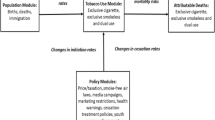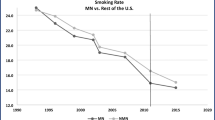Abstract
This paper investigates the impact of cigarette prices on adults’ smoking and smokeless tobacco (SLT) use initiation and cessation decisions in India from 1980 to 2017. We use individual-level data from the 2017 Global Adult Tobacco Survey (GATS) to recreate the smoking history of current or past adult tobacco users using self-reported data on the years of tobacco use, initiation, and cessation merged with historical data on cigarettes, bidis, and SLT product prices. To estimate the effect of price changes on smoking and SLT use transitions, we use a pooled linear model and propensity score matching (PSM) to construct an artificial treatment group where weights capture the likelihood of being an ever-smoker. We find that price increases are a statistically significant deterrent to smoking initiation, with price elasticity of initiation being on average -0.0236 (CI: -0.024 -0.023) and -0.000428 (0.0 – 0.0) for smoking and SLT, respectively. This implies, for example, that a 10% increase in prices results in a 0.24% smaller smoking initiation and 0.004% smaller SLT use initiation. We find that prices can also encourage quitting, but the effects are not always significant, with elasticities of 0.0218 (CI: 0.017 0.026) and 0.0026 (CI: 0.001 0.004) for smoking and SLT, respectively. This implies that a 10% increase in prices will result in a 0.22% increase in the probability of quitting smoking and a 0.03% increase in the probability of quitting SLT use. The elasticity varied by income group, gender, and between young and all adults, with larger effects among lower-income adults and especially among young females. Higher cigarette prices that can be achieved by tobacco tax increases can significantly reduce initiation and encourage cessation, thus improving public health, especially among the most vulnerable population subgroups.
Similar content being viewed by others
Notes
Filmer and Pritchett (2001) note that asset-based measures describe an individual or a household’s long-run economic status and therefore do not necessarily reflect short-term fluctuations in economic well-being or economic shocks. Thus, although we expect the income variable to be correlated with the wealth measure estimated here, we are aware that the two might tap different dimensions of economic well-being.
Chi-squared tests between regressions using SUR (seemingly unrelated regressions) reveal that differences between price elasticity coefficients for low-income vs. middle-income, low-income vs. high-income and middle-income with high-income were not statistically significant for both smoking and smokeless regression as shown in Table 5.
In India, tax on smokeless products is applied as ad valorem (a percentage of retail price), whereas for both cigarettes and bidis, the taxation has both an ad valorem tax and a specific component applied per stick. More details on taxation of tobacco products before the introduction of Goods and Services taxation in 2017 and after it are available elsewhere (John et al., 2010, 2019).
In comparison, the full-price elasticity of demand of SLT use in India, including changes in the extensive margin (changes in the prevalence of SLT use) and at the intensive margin (changes in the intensity of use for each user), has been found to range between -0.5 to -1 (John, 2008; Selvaraj et al., 2015).
These regressions are available upon request.
References
Cui, Y., Forget, E. L., Zhu, Y., Torabi, M., & Oguzoglu, U. (2018). The effects of cigarette price and the amount of pocket money on youth smoking initiation and intensity in Canada. Canadian Journal of Public Health = Revue Canadienne de Santé Publique, 110(1), 93–102.
Dauchy, E., & Ross, H. (2019). The effect of price and tax policies on the decision to smoke among men in Kenya. Addiction (Abingdon, England), 114(7), 1249–1263. https://doi.org/10.1111/add.14623
Filmer, D., & Pritchett, L. H. (2001). Estimating wealth effects without expenditure data–or tears: An application to educational enrollments in states of India. Demography, 38(1), 115–132. https://doi.org/10.1353/dem.2001.0003
Franco-Churruarin, F., & Gonzalez-Rozada, M. (2021). The impact of cigarette price increases on the prevalence of daily smoking and initiation in Mexico. Tobacconomics, Institute for Health Research and Policy, University of Illinois Chicago.
Global Tobacco Economics Consortium (2018). The health, poverty, and financial consequences of a cigarette price increase among 500 million male smokers in 13 middle income countries: Compartmental model study. BMJ, 361, k1162. https://doi.org/10.1136/bmj.k1162
Goodchild, M., Sinha, P., Gill Munish, V., & Tullu, F. T. (2020). Changes in the affordability of tobacco products in India during 2007/2008 to 2017/2018: A price-relative-to-income analysis. WHO South-East Asia Journal of Public Health, 9(1), 73–81. https://doi.org/10.4103/2224-3151.283001
Government of India. (2017). Global Adult Tobacco Survey (GATS India Report) 2016–2017. New Delhi, India: Ministry of Health and Family Welfare, Government of India; Tata Institute of Social Sciences.
Guindon, G. E., Fatima, T., Li, D. X., Joukova, A., Sudhir, J., Mishra, S., … & Jha, P. (2019). Visualizing data: Trends in smoking tobacco prices and taxes in India. Gates Open Research, 3. https://doi.org/10.12688/gatesopenres.12894.1
Guindon, G. E., Nandi, A., Chaloupka, F. J., & Jha, P. (2011). Socioeconomic Differences in the Impact of Smoking Tobacco and Alcohol Prices on Smoking in India. National Bureau of Economic Research Working Paper Series, No. 17580. Retrieved from http://www.nber.org/papers/w17580
John, R. M. (2008). Price Elasticity Estimates for Tobacco in India. Health Policy and Planning, 23(3), 200–209.
John, R. M., & Dauchy, E. (2020). Trends in affordability of tobacco products before and after the transition to GST in India. Tobacco Control. https://doi.org/10.1136/tobaccocontrol-2019-055525
John, R. M., Dauchy, E., & Goodchild, M. (2019). Estimated impact of the GST on tobacco products in India. Tobacco Control, 28(5), 506–512. https://doi.org/10.1136/tobaccocontrol-2018-054479
John, R. M., Rao, R. K., Rao, M. G., Moore, J., Deshpande, R., Sengupta, J., ... & Jha, P. (2010). The Economics of Tobacco and Tobacco Taxation in India. International Union Against Tuberculosis and Lung Disease.
Joseph, R. A., & Chaloupka, F. J. (2014). The Influence of Prices on Youth Tobacco Use in India. Nicotine & Tobacco Research, 16(Suppl 1), S24–S29. https://doi.org/10.1093/ntr/ntt041
Keeler, C., Max, W., Yerger, V. B., Yao, T., Wang, Y., Ong, M. K., & Sung, H.-Y. (2020). Effects of Cigarette Prices on Intention to Quit, Quit Attempts, and Successful Cessation Among African American Smokers. Nicotine & Tobacco Research: Official Journal of the Society for Research on Nicotine and Tobacco, 22(4), 522–531. https://doi.org/10.1093/ntr/nty149
Kostova, D., Chaloupka, F. J., & Shang, C. (2014). A duration analysis of the role of cigarette prices on smoking initiation and cessation in developing countries. The European Journal of Health Economics: HEPAC: Health Economics in Prevention and Care. https://doi.org/10.1007/s10198-014-0573-9
Kostova, D., Husain, M. J., & Chaloupka, F. J. (2016). Effect of cigarette prices on smoking initiation and cessation in China: A duration analysis. Tobacco Control, 26(5), 569–574. https://doi.org/10.1136/tobaccocontrol-2016-053338
Krefis, A. C., Schwarz, N. G., Nkrumah, B., Acquah, S., Loag, W., Sarpong, N., ... & May, J. (2010). Principal component analysis of socioeconomic factors and their association with malaria in children from the Ashanti Region Ghana. Malaria Journal, 9(1), 201. https://doi.org/10.1186/1475-2875-9-201
Labour Bureau. (2020). Retail Prices from Consumer Price Index for Industrial Workers. Chandigarh, India: Ministry of Labor and Employment, Government of India. Retrieved from Ministry of Labor and Employment, Government of India website: http://labourbureaucpi.gov.in/
Lance, P. M., Akin, J. S., Dow, W. H., & Loh, C.-P. (2004). Is cigarette smoking in poorer nations highly sensitive to price?: Evidence from Russia and China. Journal of Health Economics, 23(1), 173–189. https://doi.org/10.1016/j.jhealeco.2003.09.004
Mirza, M. (2019). Large Tax Increases Are the Most Effective Policy for Reducing Tobacco Use. Chicago, IL: Tobacconomics, Health Policy Center, Institute for Health Research and Policy, University of Illinois at Chicago.
Nargis, N., Stoklosa, M., Drope, J., Fong, G. T., Quah, A. C. K., Driezen, P., ... & Hussain, A. K. M. G. (2019). Trend in the affordability of tobacco products in Bangladesh: Findings from the ITC Bangladesh Surveys. Tobacco Control, 28(Suppl 1), s20–s30. https://doi.org/10.1136/tobaccocontrol-2017-054035
NCI & WHO. (2016). The Economics of Tobacco and Tobacco Control (No. NIH Publication No. 16-CA-8029A). Bethesda, MD: U.S. Department of Health and Human Services, National Institutes of Health, National Cancer Institute; and Geneva, CH: World Health Organization.
Oehlert, G. W. (1992). A Note on the Delta Method. The American Statistician, 46(1), 27–29. https://doi.org/10.1080/00031305.1992.10475842
Office of the Economic Adviser. (2020). Commodity Specific Wholesale Price Series. Department of Industrial Policy and Information (DIPP), Ministry of Commerce and Industry, Government of India.
Palipudi, K. M., Gupta, P. C., Sinha, D. N., Andes, L. J., Asma, S., McAfee, T., & on behalf of the GATS Collaborative Group. (2012). Social Determinants of Health and Tobacco Use in Thirteen Low and Middle Income Countries: Evidence from Global Adult Tobacco Survey. PLoS One, 7(3), e33466. https://doi.org/10.1371/journal.pone.0033466
Reddy, K. S., & Gupta, P. C. (2004). Report on Tobacco Control in India. Ministry of Health and Family Welfare, Government of India.
Seabrook, R. (2010). A new measure of alcohol affordability for the UK. Alcohol and Alcoholism (oxford, Oxfordshire), 45(6), 581–585. https://doi.org/10.1093/alcalc/agq072
Selvaraj, S., Srivastava, S., & Karan, A. (2015). Price elasticity of tobacco products among economic classes in India, 2011–2012. BMJ Open, 5(12). https://doi.org/10.1136/bmjopen-2015-008180
Social Policy and Development Centre. (2021). The Cost of Inaction: Implications of the Cigarette Tax Policy in Pakistan. Karachi, Pakistan. Retrieved from https://tobacconomics.org/research/the-cost-of-inaction-implications-of-the-cigarette-tax-policy-in-pakistan/
Wall, M., & Casswell, S. (2013). Affordability of alcohol as a key driver of alcohol demand in New Zealand: A co-integration analysis. Addiction (Abingdon, England), 108(1), 72–79. https://doi.org/10.1111/j.1360-0443.2012.03992.x
Wang, R., Jiang, Y., Li, X., Zhao, Q., Zhu, M., Guan, Y., & Zhao, G. (2019). Relationships between smoking duration, smoking intensity, hypothetical tobacco price increases, and smoking habit change intention among current smokers in Shanghai. The Journal of International Medical Research, 47(10), 5216–5228. https://doi.org/10.1177/0300060519868131
World Health Organization. (2015). WHO report on the global tobacco epidemic, 2015: Raising taxes on tobacco. Geneva, Switzerland. Retrieved from http://www.who.int/tobacco/global_report/2015/report/en/
World Health Organization. (2019). WHO global report on trends in prevalence of tobacco use 2000–2025, third edition. Geneva, Switzerland: World Health Organization. Retrieved from World Health Organization website: https://www.who.int/publications/i/item/who-global-report-on-trends-in-prevalence-of-tobacco-use-2000-2025-third-edition
Wu, D. C., Sheel, V., Gupta, P., Essue, B. M., Luong, L., & Jha, P. (2020). Impact of cigarette tax increase on health and financing outcomes in four Indian states. Gates Open Research, 4, 49. https://doi.org/10.12688/gatesopenres.13127.1
Xu, J., & Long, J. S. (2005). Confidence Intervals for Predicted Outcomes in Regression Models for Categorical Outcomes. The Stata Journal, 5(4), 537–559. https://doi.org/10.1177/1536867X0500500405
Zellner, A. (1962). An Efficient Method of Estimating Seemingly Unrelated Regressions and Tests for Aggregation Bias. Journal of the American Statistical Association, 57(298), 348–368. https://doi.org/10.2307/2281644
Zellner, A. (1963). Estimators for Seemingly Unrelated Regression Equations: Some Exact Finite Sample Results. Journal of the American Statistical Association, 58(304), 977–992. https://doi.org/10.1080/01621459.1963.10480681
Funding
This study was fully funded by the Campaign for Tobacco-free Kids.
Author information
Authors and Affiliations
Corresponding author
Ethics declarations
Ethics approval
This is an observational study and there are no human subjects involved. Hence an ethics approval is not required.
Consent to participate
Not applicable.
Conflicts of interest/Competing interests
The authors have no conflicts of interest to declare that are relevant to the content of this article.
Additional information
Publisher's Note
Springer Nature remains neutral with regard to jurisdictional claims in published maps and institutional affiliations.
Supplementary Information
Below is the link to the electronic supplementary material.
Rights and permissions
About this article
Cite this article
Dauchy, E.P., John, R.M. The Effect of Price and Tax Policies on the Decision to Smoke or Use Smokeless Tobacco in India. Prev Sci 23, 1101–1114 (2022). https://doi.org/10.1007/s11121-022-01360-w
Accepted:
Published:
Issue Date:
DOI: https://doi.org/10.1007/s11121-022-01360-w




